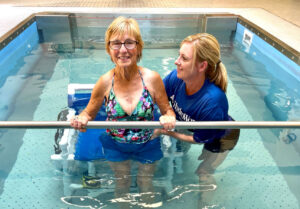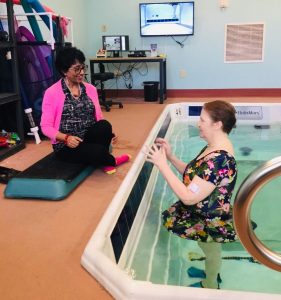10 Facts for National Physical Therapy Month
October 2022 is the 30th anniversary of National Physical Therapy Month! We are recognizing the dedication and commitment that many physical therapists show daily to their patients and practices.
National Physical Therapy Month (NPTM) is a commemoration held each October by the American Physical Therapy Association (APTA). NPTM is designed to recognize the impact that physical therapists and physical therapist assistants make in restoring and improving motion in people’s lives.
10 Facts About Physical Therapy
- According to the Bureau of Labor Statistics, the Employment of physical therapists is projected to grow 17 percent from 2021 to 2031, much faster than the average for all occupations.
- In 1921, Mary McMillian founded the first professional association called the American Women’s Physical Therapeutic Association. This later became the APTA.
- In addition to graduating from an accredited program, students must also pass a licensure exam to be certified as a physical therapist.
- According to the APTA Consumer Research report, “physical therapy users were more likely in 2021 than they were in 2016 to say they would consider seeing a PT without first receiving a referral.”
- Physical therapists are creative! They adapt movements and exercises to meet the mobility and strength level of each client based on their current ability.
- There are many different types of physical therapists. Many work for outpatient clinics, hospitals, schools, fitness centers, senior care centers, home health agencies, colleges & universities, and more!
- During World War I, the army utilized “reconstruction aides,” who were nurses tasked with rehabilitating wounded soldiers through occupational and physical therapy.
- Although many people think physical therapists only rehabilitate injuries, they actually work to prevent injuries as well by educating patients on safer movements and motions.
- Specially-trained physical therapists can aid with a variety of medical issues. From vestibular rehabilitation specialists who help minimize balance disorders to women’s health specialists who perform pelvic floor rehabilitation, physical therapy encompasses a broad range of treatments.
- The term “physical therapy” can include orthopedic, acute care, post-operative care, cardiovascular and pulmonary rehab, lymphedema management, wound care, and neurologic rehabilitation.
How Do Physical Therapists Help With Recovery?
Physical therapists, whether on land or in the water, have an established history of helping individuals improve their quality of life, regardless of the type of injury or rehabilitation. Physical therapists and Aquatic Physical Therapists, received specialized education in a variety of sciences, therefore they have a great understanding of how the body works and how to get you moving again. They have been educated on how to restore and maximize mobility for each individual patient with whom they are working.
Whether you are living with diabetes or recovering from a stroke, a fall or a sports injury, a physical therapist and/or an aquatic physical therapist can work closely with you to evaluate your condition and develop an effective plan of care, specific to each patient.
More about Aquatic Physical Therapy from the Aquatic Physical Therapy Section of the APTA:
“Aquatic Physical Therapy is the evidence-based and skilled practice of physical therapy in an aquatic environment by a physical therapist, or a physical therapist assistant under the supervision of a physical therapist. Aquatic Physical Therapy includes but is not limited to treatment, rehabilitation, prevention, health, wellness and fitness of patient/client populations in an aquatic environment with or without the use of assistive, adaptive, orthotic, protective, or supportive devices and equipment.
The unique properties of the aquatic environment enhance interventions for patients/clients across the age span with musculoskeletal, neuromuscular, cardiovascular/pulmonary, and integumentary diseases, disorders, or conditions.”
Personal testimony from a hydrotherapy patient:
“I was having long term daily pain when I read an article about a new physical therapy office called River Rock moving into Westchester. I decided to stop by and inquire about their services in water. That was a fantastic visit.
After I started going 2x a week. I began feeling better and the staff are incredibly caring. The water pool has been life changing for me. I have been going for 2x a week for 5 months and feel so much better. I have considerably less pain in my back and knees without prescription medicine. I have had osteoarthritis for 60 years and am stronger than ever.”
– Jan, patient at River Rock PT
Which HydroWorx Is Best for Physical Therapists?
Regardless of the size, all of our underwater treadmills provide physical therapists with the resources to create an infinite amount of rehabilitation programs.
With varying treadmill speeds, resistance jets, adjustable water levels, and the addition of weights or other tools, physical therapists can develop customized plans for each patient using one HydroWorx system.
Our aquatic therapy product line has a variety of options to suit nearly any physical therapy clinic scenario.
If you have an existing space, our free-standing units can be easily installed and do not require construction. If your facility is renovating, expanding, or building a new location, our in-ground pools may be a suitable option for your needs.
In order to determine which product is best for you, it is important to consider your patients’ needs and your goals for the future. Our team has helped hundreds of clinics work through this evaluation process and create a strategy for a successful aquatic therapy program.
Next step: Connect with our team for a strategy session
The above facts and information were derived from the following sites:
https://www.athletico.com/2011/09/27/the-top-10-things-you-did-not-know-about-physical-therapy/
https://www.atipt.com/blog/lets-celebrate-national-physical-therapy-month
One comment on “10 Facts for National Physical Therapy Month”
Comments are closed.





We agree – going to a physical therapist is essential!